Feeding a puppy a raw food diet has gained popularity among pet owners. The main approach is to provide their furry companions with a natural and nutrient-rich approach to nutrition. Raw diets consist of fresh, unprocessed ingredients such as raw meat, bones, organs, fruits, and vegetables.
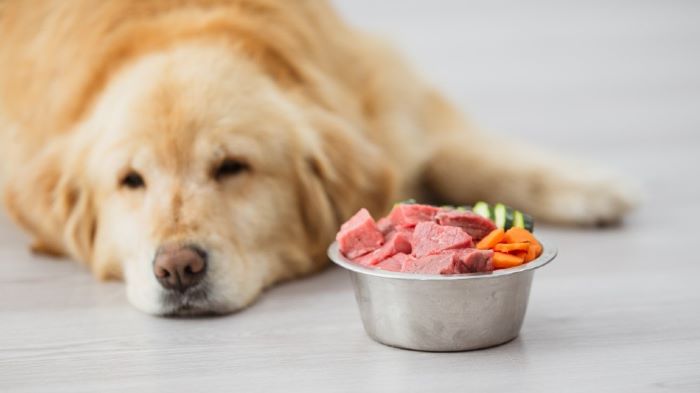
Feeding your puppy a raw food diet requires careful planning, attention to nutritional balance, and adherence to proper handling and hygiene practices. By understanding the amount of raw food to feed, considering age and weight factors, and being aware of the potential benefits and considerations, you can make informed decisions regarding your puppy’s nutrition.
The Dietary Need of a Puppy
The quality of your puppy’s raw food will directly affect its growth and health. Since they are at a growing stage, they need more nutritional values as compared to adult dogs.
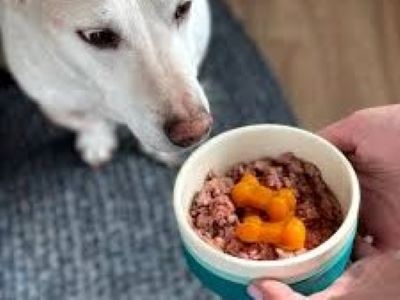
When choosing a diet for your growing puppy it is important to understand four key nutrients. These are protein, fat, calcium, and digestible carbohydrates.
Protein
“Puppies need more amount of protein to support their rapid growth and development. It serves as the foundation for building muscles. Protein in dog food also assists with muscle, skin, hair, nail, and blood formation”, confirms Dr Tiffany Tupler at PetMD.
Fat
High-energy puppies use fat as an energy source. They need higher levels of essential fatty acids. Fat also ensures fat-soluble vitamins are properly absorbed by the body.
When you’re planning a raw diet, go with a protein source that’s a bit fattier than normal. The best option is to use proteins that have healthy fat, such as fish.
Calcium
Calcium helps puppies develop strong bones and teeth. It typically comes from the meat source, bones, and cartilage.
It is important to keep a check on the calcium requirements. Additional supplements are not required as meat has enough calcium to fulfil a puppy’s needs. Too much calcium can lead to abnormal bone growth.
Carbohydrates
Carbohydrates play important roles in your dog’s body. Dietary carbohydrates are usually not considered essential nutrients for puppies. But, carbohydrates are important for providing a highly digestible, readily available energy source. Grains are a common source of carbohydrates in dog foods.
Amino Acids
Arginine, Histidine, Isoleucine, Leucine, and Lysine are some essential Amino Acids that must be provided to a dog. They play an important role in other systems such as regulating hormones as well as neurotransmitters[1].
Benefits of a Daily Raw Diet
Though there are many dry kibble and canned food available in the market, raw food has its own perks in the overall development of your puppy. Incorporating raw food into a dog’s diet can help your pet feel and look its best.
Dogs have natural physical characteristics designed to derive their nutrients from raw animal protein, bone, and fat. Feeding only raw food to your pet will make your pet experience the most benefits. If not, adding just 25% raw food to their daily diet can make a huge difference in their development.
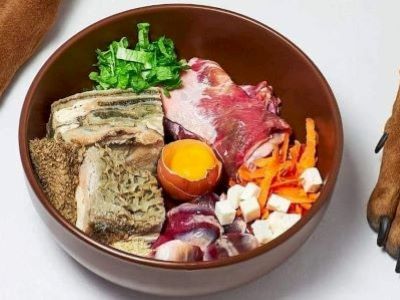
Dr Amy Flowers from WebMD suggests some benefits, Here are some of them:
- Improved Nutritional Balance: Raw diets for puppies can provide a more natural and balanced nutrient profile compared to commercial pet foods. Raw diets typically include raw meat, bones, organs, fruits, vegetables, and supplements, aiming to mimic a dog’s ancestral diet.
- Enhanced Digestion: Raw diets may promote better digestion in puppies due to their high moisture content and natural enzymes. The raw, unprocessed ingredients can be easier to digest, reducing digestive issues in puppies.
- Healthy Coat and Skin: The high-quality protein, essential fatty acids, and vitamins present in raw foods can support a shiny coat, reduce shedding, and minimize skin problems such as dryness and itchiness.
- Dental Health: Chewing on raw meaty bones can help promote dental health in puppies. Gnawing on bones can assist in cleaning teeth, reducing plaque and tartar buildup, and supporting strong jaw muscles.
- Improved Energy and Vitality: Puppies on a raw diet may exhibit increased energy levels and overall vitality. The nutrient-dense, unprocessed nature of raw foods can provide puppies with the necessary fuel for optimal growth, development, and an active lifestyle.
- Weight Management: Raw diets can aid in weight management for puppies. With a proper portion of nutrient profile, raw diets can help maintain a healthy body weight.
While raw diets aim to mimic a dog’s natural diet, some pet owners opt for vegan dog food uk, which uses plant-based proteins and supplements.
What Should I Feed My Puppy?
Not all raw food for dogs is the same or healthy. It is necessary to know the proper nutritional need of your puppy and plan a balanced diet accordingly.
Thus, to ensure the rapid and healthy growth of your puppy it is important to balance the nutrients and enhance it by adding supplements.
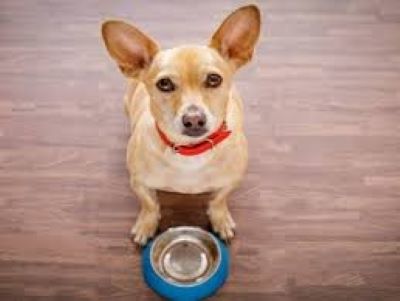
Feed your puppy with one protein source
It is advisable to start with one source of protein. Try this source for about a week. If there are no signs of digestive problems, start with another source.
Proteins are the best for building muscles and supporting body growth. Hence, choosing the right source of protein is important.
Balancing calcium and phosphorus
Calcium is responsible for bone development. Phosphorous is another essential nutrient that works alongside calcium to build bones. But calcium proportion should not be more otherwise it could lead to abnormal bone growth.
Some of the sources balancing calcium and phosphorus are:
- Turkey tails and necks
- Chicken backs and necks
- Veal ribs and tails
- Chicken feet and beef windpipes
- Beef neck bones
How Much Raw Food to Feed?
Feeding a puppy a raw food diet can be a healthy and nutritious option. The amount of raw food to feed a puppy depends on several factors, including age, weight, and activity level. It is important to consult with a veterinarian to determine the specific needs of your puppy.
As a general guideline, puppies typically require more food per pound of body weight compared to adult dogs. A common recommendation is to feed puppies 2-3% of their body weight in raw food per day.
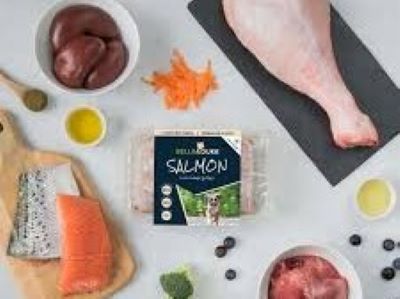
Some people believe the idea of ‘Free Feeding’ is to provide an endless supply of food. By this method, puppies have access to food whenever they need it. But such practice is not recommended.
This can be divided into multiple meals throughout the day. For example, if your puppy weighs 10 pounds, you would feed them approximately 0.2-0.3 pounds of raw food per day. This can be divided into two or three meals.
Considering their age
Puppies have different nutritional needs at different stages of their growth. As a general guideline, puppies can be divided into three age categories:
- 0-4 months (up to 16 weeks): During this stage, puppies require a higher caloric intake to support rapid growth. The daily food portion should be approximately 8-10% of their body weight divided into multiple meals.
- 4-7 months (16 weeks to 7 months): Puppies continue to grow but at a slower pace. The daily food portion can be reduced to around 6-8% of their body weight divided into two or three meals.
- 7-12 months (7 months to 1 year): Puppies are considered adolescents during this stage. The daily food portion can be further reduced to approximately 4-6% of their body weight divided into two meals.
Considering their weight
The puppy’s current weight is another important factor to consider when determining the amount of raw food to feed. Here’s a breakdown based on weight ranges:
- Small breeds (under 20 pounds or 9 kg): Feed around 5-8% of their body weight per day.
- Medium breeds (20-50 pounds or 9-23 kg): Feed approximately 4-6% of their body weight per day.
- Large breeds (50-100 pounds or 23-45 kg): Feed roughly 3-4% of their body weight per day.
- Giant breeds (over 100 pounds or 45 kg): Feed about 2-3% of their body weight per day.
Regularly assess your puppy’s body condition to ensure they are maintaining a healthy weight. You should be able to feel their ribs with a slight fat cover.
If the puppy becomes overweight or underweight, adjust the portion sizes accordingly. Regularly consult with a professional to ensure your puppy is receiving the appropriate amount of nutrition.
Transitioning to Raw Food
The transition from cooked or packed food to raw food may take time. This time period totally depends on overall growth and health issues like digestion
Gradually introducing raw foods into your pup’s diet is an important step in transitioning them to a raw food diet. This process allows their digestive system to adjust to the new diet and helps prevent any potential digestive upset.
Some pet owners may wonder, can dogs eat marmite or yeast spreads as part of a raw food diet? This is generally not recommended, as the high salt content can be unhealthy for dogs.
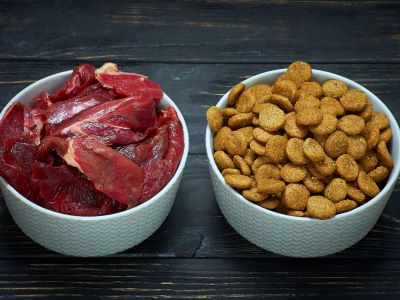
Getting Started with Raw Food
Every owner needs to take care that the transition for puppies might vary. Thus, you should not force your puppy to eat just raw food from the very first day. Here are some steps to follow:
1. Start with Small Portions: This can be done by mixing a small amount of raw meat or raw food with regular kibble or canned food. Start with a ratio of approximately 90% regular food and 10% raw food.
2. Monitor Digestive Response: Keep a close eye on your pup’s digestive response to raw food. Observe any changes in their stools, overall digestion, and appetite. If you notice any signs of discomfort or digestive issues, it may be necessary to slow down the transition process or consult with a veterinarian.
3. Increase Raw Food Proportion: Gradually increase the proportion of raw food in your pup’s meals over time. Aim to increase the raw food portion by approximately 10% every few days, while decreasing the regular food portion accordingly.
4. Monitor Energy Levels and Overall Health: Throughout the transition process, keep an eye on your pup’s energy levels and overall health. A successful transition should result in improved energy, a healthy coat, and overall vitality. If you notice any concerning changes, consult with your veterinarian for guidance.
5. Transition to a Fully Raw Diet: Over a period of several weeks, gradually increase the proportion of raw food and decrease the regular food until your pup is solely consuming a raw food diet. This process may take some time, and it is essential to listen to your pup’s individual needs and adjust the transition speed accordingly.
“Raw meat and bones carry bacteria that can make both animals and humans ill and so are not recommended. It is recommended that you choose only human-grade raw meat and bones.”
“You should avoid raw meat products such as sausages, sausage meat, and cooked manufactured meats as they can contain sulfite preservatives”, say the experts from RSPCA.
On a note, every pup is unique, and the transition to a raw food diet may vary depending on factors such as age, breed, and individual dietary needs. Consulting with a veterinarian throughout the process is crucial to ensure a safe and successful transition.
Also refer to this raw dog food guide tips for gradually transitioning your puppy to a raw food diet
FAQs
How much raw food should I give a puppy?
Puppies should be fed 5-6% of their growing body weight. Some puppies may need, more or less to maintain proper weight.
How do you measure raw food for puppies?
Feed approximately 2-3% of your dog’s weight daily and split this between two meals.
Is raw food enough for a puppy?
Puppies can eat raw food just like an adult dog can! No matter the age or breed, puppies can start eating raw dog food as early as 4 weeks old.
Do dogs live longer on a raw diet?
Yes. studies have shown that dogs who eat a raw diet live as much as 3 years longer than their kibble-fed counterparts.
Summary
Thus, feeding a puppy raw food is very beneficial to its overall growth and development. However, the amount of raw food totally depends on your puppy. Its breed, age, weight, activeness, and many other factors are taken into consideration.
Remember, every pup is unique and the body changes due to the raw intake can be sometimes positive as well as negative. It is better to consult a professional whenever you encounter any abnormality.
Reference:
- Ardente, A., DVM Ph.D. (2022b). Pet food ingredient and label guide. www.petmd.com.- PetMD.



